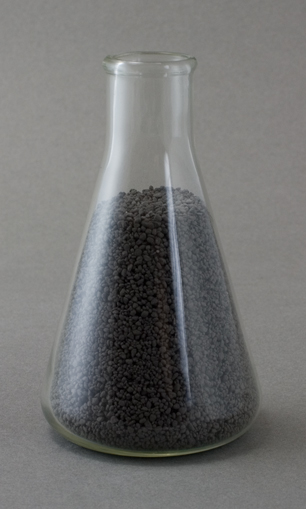Birm: Efficient, Economic Iron/Manganese Removal

The following product information is based on literature of the Clack Corporation, manufacturer of Birm Iron/Manganese removal media.
Birm is an efficient and economical method of removing dissolved iron and manganese compounds from raw water supplies. It may be used in either gravity-fed or pressurized water treatment systems. Birm acts as an insoluble catalyst to enhance the reaction between dissolved oxygen (D.O.) and the iron compounds.
In ground waters the dissolved iron is usually in the ferrous bicarbonate state due to the excess of free carbon dioxide and is not filterable. Birm, acting as a catalyst between the oxygen and the soluble iron compounds, enhances the oxidation reaction of Fe + + to Fe + + + and produces ferric hydroxide which precipitates and may be easily filtered.
The physical characteristics of Birm provide an excellent filter media which is easily cleaned by backwashing to remove the precipitant. Birm is not consumed in the iron removal operation and therefore offers a tremendous economic advantage over many other iron removal methods.
Other advantages of Birm include: long material life with relatively low attrition loss, a wide temperature performance range and extremely high removal efficiency. Negligible labor costs are involved because Birm does not require chemicals for regeneration, only periodic backwashing is required.
When using Birm for iron removal, it is necessary that the water contain no oil or hydrogen sulfide. Organic matter should not exceed 4-5 ppm, and the D.O. content should be equal to at least 15% of the iron content with a pH of 6.8 or more. If the influent water has a pH of less than 6.8 dissolved chemicals such as Clack Corosex, Calcite or soda ash may be used to raise the pH. A water having a low D.O. level may be pre-treated by aeration. Chlorination greatly reduces Birm's activity and dosages should be held at minimum.
Birm is furnished in two grades, regular and fine. Regular is generally recommended for industrial, municipal and most domestic installations. Fine is recommended on domestic installations where backwash rates are limited.
Clack's Birm may also be used for manganese removal with the same dependability as iron removal. In these applications the water to be treated should have a pH of 8.0-9.0 for best results. If the water also contains iron, the pH should be below 8.5. High pH conditions may cause the formation of colloidal iron which is very difficult to filter out. All other conditions remain the same for either manganese or iron removal.
Advantages:
No chemicals to purchase for maintenance. No regeneration required. Iron removal efficiency is very high. Only periodic backwashing required. Durable material with a long life and a wide temperature range. Light in weight: only 46-50 lbs. per cubic foot.
Conditions for Operation:
- Alkalinity should be greater than two times the combined sulfate and chloride concentration.
- pH should be 6.8+.
- Dissolved Oxygen content must be equal to at least 15% of the iron (or iron and manganese) content.
- Bed Depth: 30 to 36 inches.
- Backwash rate: 10 to 12 gpm per square foot for regular Birm. 8 to 10 gpm per square foot for fine Birm. (See note below.)
- Backwash bed expansion: 35% to 50%.
Note from Pure Water Products: Do not confuse square feet with cubic feet. The backwash requirement is based on the cross-sectional square foot surface of the birm bed, not on the total cubic feet of birm in the filter. (The square foot total is considerably less than the cubic foot total. For example, a nine-inch diameter filter tank has a 0.442 square foot filter media surface. A ten-inch diameter tank has 0.545 square feet and a 12-inch diameter tank has 0.785 square feet. Therefore, a ten-inch tank would need about five or six gallons per minute backwash capacity with regular Birm.)
Site Index
Filtration Systems
- Aeration for Iron & Sulfide
- Backwashing Filters
(whole house & well units)
- Chlorine & Chemical Injectors
- Countertop Water Filters
- Emergency Filters
- Garden Hose Filters
- Reverse Osmosis, Residential
- Reverse Osmosis, Commercial
- Shower Filters
- Specialty Filters
- Ultraviolet Systems
- Undersink Filters
- Water Softeners
- Whole House Filters
Cartridges
Parts
- Replacement Parts
- Faucets
- Filter Media
- Fittings
- Housings
- O-rings
- Pumps
- Pura UV
- R.O. Parts
- R.O. Tanks
- R.O. Booster Pump
- VIQUA UV